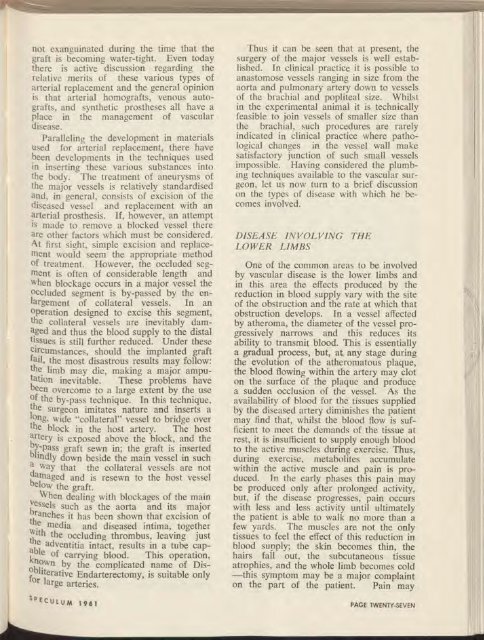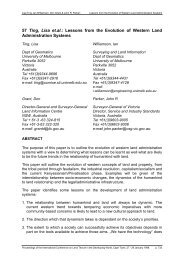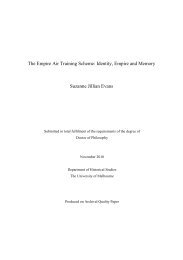1 - University of Melbourne
1 - University of Melbourne
1 - University of Melbourne
- No tags were found...
Create successful ePaper yourself
Turn your PDF publications into a flip-book with our unique Google optimized e-Paper software.
not exanguinated during the time that thegraft is becoming water-tight. Even todaythere is active discussion regarding therelative merits <strong>of</strong> these various types <strong>of</strong>arterial replacement and the general opinionis that arterial homografts, venous autografts,and synthetic prostheses all have aplace in the management <strong>of</strong> vasculardisease.Paralleling the development in materialsused for arterial replacement, there havebeen developments in the techniques usedin inserting these various substances intothe body. The treatment <strong>of</strong> aneurysms <strong>of</strong>the major vessels is relatively standardisedand, in general, consists <strong>of</strong> excision <strong>of</strong> thediseased vessel and replacement with anarterial prosthesis. If, however, an attemptis made to remove a blocked vessel thereare other factors which must be considered.At first sight, simple excision and replacementwould seem the appropriate method<strong>of</strong> treatment. However, the occluded segmentis <strong>of</strong>ten <strong>of</strong> considerable length andwhen blockage occurs in a major vessel theoccluded segment is by-passed by the enlargement<strong>of</strong> collateral vessels. In anoperation designed to excise this segment,the collateral vessels are inevitably damagedand thus the blood supply to the distaltissues is still further reduced. Under thesecircumstances, should the implanted graftfail, the most disastrous results may follow:the limb may die, making a major amputationinevitable. These problems havebeen overcome to a large extent by the use<strong>of</strong> the by-pass technique. In this technique,the surgeon imitates nature and inserts along, wide "collateral" vessel to bridge overthe block in the host artery. The hostartery is exposed above the block, and theby-pass graft sewn in; the graft is insertedblindly down beside the main vessel in sucha way that the collateral vessels are notkdamaged and is resewn to the host vessel°elow the graft.When dealing with blockages <strong>of</strong> the mainvessels such as the aorta and its majorbranches it has been shown that excision <strong>of</strong>the media and diseased intima, togetherwith the occluding thrombus, leaving justthe adventitia intact, results in a tube capable<strong>of</strong> carrying blood. This operation,known by the complicated name <strong>of</strong> Dis-Obliterative Endarterectomy, is suitable onlyfor large arteries.SPECULUM 1961Thus it can be seen that at present, thesurgery <strong>of</strong> the major vessels is well established.In clinical practice it is possible toanastomose vessels ranging in size from theaorta and pulmonary artery down to vessels<strong>of</strong> the brachial and popliteal size. Whilstin the experimental animal it is technicallyfeasible to join vessels <strong>of</strong> smaller size thanthe brachial, such procedures are rarelyindicated in clinical practice where pathologicalchanges in the vessel wall makesatisfactory junction <strong>of</strong> such small vesselsimpossible. Having considered the plumbingtechniques available to the vascular surgeon,let us now turn to a brief discussionon the types <strong>of</strong> disease with which he becomesinvolved.DISEASE INVOLVING THELOWER LIMBSOne <strong>of</strong> the common areas to be involvedby vascular disease is the lower limbs andin this area the effects produced by thereduction in blood supply vary with the site<strong>of</strong> the obstruction and the rate at which thatobstruction develops. In a vessel affectedby atheroma, the diameter <strong>of</strong> the vessel progressivelynarrows and this reduces itsability to transmit blood. This is essentiallya gradual process, but, at, any stage duringthe evolution <strong>of</strong> the atheromatous plaque,the blood flowing within the artery may cloton the surface <strong>of</strong> the plaque and producea sudden occlusion <strong>of</strong> the vessel. As theavailability <strong>of</strong> blood for the tissues suppliedby the diseased artery diminishes the patientmay fmd that, whilst the blood flow is sufficientto meet the demands <strong>of</strong> the tissue atrest, it is insufficient to supply enough bloodto the active muscles during exercise. Thus,during exercise, metabolites accumulatewithin the active muscle and pain is produced.In the early phases this pain maybe produced only after prolonged activity,but, if the disease progresses, pain occurswith less and less activity until ultimatelythe patient is able to walk no more than afew yards. The muscles are not the onlytissues to feel the effect <strong>of</strong> this reduction inblood supply; the skin becomes thin, thehairs fall out, the subcutaneous tissueatrophies, and the whole limb becomes cold—this symptom may be a major complainton the part <strong>of</strong> the patient. Pain mayPAGE TWENTY-SEVEN

















